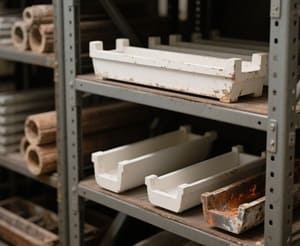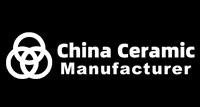Why Are Alumina Boats Ideal for High-Temperature Furnace Applications?
Alumina boats are critical components in high-temperature furnace setups used in industries like semiconductor manufacturing, materials synthesis, and crystal growth. Their ability to withstand extreme heat, resist chemical attack, and maintain structural integrity ensures efficient and safe furnace operations. This article explores the reasons behind their ideal suitability, covering properties, manufacturing factors, comparisons with alternative materials, and future trends.
At China Ceramic Manufacturer, we specialize in high-quality alumina ceramic products, ensuring optimal performance for industrial and scientific applications.

What Exactly Is an Alumina Boat?
An alumina boat is a crucible or tray made primarily from aluminum oxide (Al2O3), designed to hold materials inside furnaces during high-temperature processes. It is prized for its chemical inertness, high melting point, and mechanical durability, making it a reliable vessel in demanding thermal environments.
| Property | Typical Range | Significance in Furnace Use |
| Purity (%) | 99.5 – 99.9 | Reduces contamination risk |
| Maximum Operating Temp | ~1700°C | Allows use in ultra-high temperature processes |
| Thermal Conductivity | 20-30 W/m·K | Supports even heat distribution |
| Flexural Strength | 250-350 MPa | Provides resistance against cracking |
| Chemical Resistance | Excellent | Withstands corrosive gases and melts |
Alumina boats are widely employed in research labs, electronics, and advanced material processing due to their robust properties.
Explore our high-quality alumina boat.
What Are the Key Properties of Alumina That Support High-Temperature Use?
Alumina’s high melting point, chemical stability, and mechanical strength make it a top choice for furnace applications. Key properties include:
- High Melting Point (~2072°C): Ensures structural integrity even at furnace peak temperatures.
- Low Thermal Expansion: Minimizes deformation and thermal shock risk during rapid temperature changes.
- Excellent Chemical Inertness: Resists attack from reactive gases and molten metals common in furnace atmospheres.
- Mechanical Strength: Supports load and pressure without fracturing.
Thermal and Mechanical Properties of Alumina vs. Other Furnace Materials:
| Material | Max Temp (°C) | Thermal Expansion (10^-6/°C) | Flexural Strength (MPa) | Chemical Resistance |
| Alumina | 2072 | 6.5 | 250-350 | Excellent |
| Silicon Carbide | 2700 | 4.0 | 200-300 | Good |
| Zirconia | 2715 | 10-12 | 400-700 | Very Good |
| Mullite | 1840 | 5-6 | 150-250 | Moderate |
This combination of properties explains alumina’s dominance in many furnace applications.
How Do Alumina Boats Handle Thermal Shock and Mechanical Stress?
Thermal shock resistance is crucial in furnaces due to rapid heating and cooling cycles. Alumina’s low thermal expansion, combined with additive-enhanced microstructures, helps absorb stresses without cracking. Its mechanical strength supports the physical weight of materials during processing.
Key Factors Enhancing Thermal Shock Resistance:
- Fine-grain structure
- Additives like MgO that inhibit grain growth
- Uniform heat distribution due to thermal conductivity
Mechanisms Contributing to Alumina’s Durability in Furnaces:
- Controlled microstructure limits crack propagation
- Stable chemical phases reduce degradation under heat
- High density prevents porous weak spots
- These features reduce failure rates and increase furnace uptime.
Why Is Chemical Stability Important in Furnace Applications?
High-temperature furnaces often contain reactive atmospheres or molten materials that can corrode or degrade containers. Alumina boats offer exceptional chemical stability, resisting oxidation, acid attack, and metal infiltration, ensuring product purity and boat longevity.
| Chemical Agents | Alumina Resistance | Typical Failure Modes in Other Materials |
| Oxygen | Excellent | Oxidation in metals, degradation in SiC |
| Halogen gases (Cl2, F2) | Good | Corrosion and etching in non-ceramics |
| Molten metals (Al, Si) | Excellent | Metal infiltration and cracking in other ceramics |
| Acids and Bases | Excellent | Chemical erosion in glass or lower-grade ceramics |
This resistance protects the furnace environment and maintains consistent processing conditions.
How Does Manufacturing Quality Affect Alumina Boat Performance?
The raw material purity, additives, and sintering processes influence the final quality of alumina boats. High-purity alumina combined with carefully selected additives like MgO or CaO improves densification and grain structure, enhancing thermal and mechanical properties.
Effects of Additives on Alumina Properties:
| Additive | Effect on Alumina | Impact on Furnace Use |
| MgO | Controls grain growth | Improves thermal shock resistance |
| CaO | Enhances densification | Increases mechanical strength |
| TiO2 | Stabilizes alumina phases | Reduces cracking during firing |
| SiO2 | Controls liquid phase formation | Lowers porosity and shrinkage defects |
Quality manufacturing leads to boats with fewer defects, longer lifespans, and better performance under furnace stresses.
How Do Alumina Boats Compare With Other Ceramic Materials Used in Furnaces?
Besides alumina, other ceramics such as silicon carbide, zirconia, and mullite are also used in high-temperature applications. Each has strengths but also limitations.
| Material | Max Temp (°C) | Mechanical Strength (MPa) | Thermal Conductivity (W/m·K) | Chemical Resistance | Cost |
| Alumina | 2072 | 250-350 | 20-30 | Excellent | Moderate |
| Silicon Carbide | 2700 | 200-300 | 120-140 | Good | High |
| Zirconia | 2715 | 400-700 | 2-3 | Very Good | Very High |
| Mullite | 1840 | 150-250 | 5-7 | Moderate | Low |
While silicon carbide excels in thermal conductivity and zirconia in toughness, alumina offers the best balance of cost, chemical resistance, and temperature capability, making it ideal for many furnace applications.
Request a custom quote for an alumina boat.
What Are the Latest Trends in Alumina Boat Technology?
Recent advances focus on improving alumina boat durability, customization, and environmental sustainability:
- Nanostructured Additives: Improve toughness and reduce defects.
- 3D Printing: Enables complex shapes and faster prototyping.
- Eco-friendly Sintering Aids: Reduce the environmental impact of manufacturing.
- Improved Quality Control: Automation and imaging enhance consistency.
These trends aim to extend boat lifespan, improve furnace efficiency, and lower costs.
FAQ
| Question | Answer |
| What max temperature can alumina boats handle? | Up to approximately 1700°C, suitable for most high-temp furnace processes. |
| How resistant are alumina boats to thermal shock? | Very resistant due to low thermal expansion and optimized microstructure. |
| Can alumina boats be custom-made? | Yes, sizes and shapes can be tailored to specific furnace setups. |
| How does alumina compare cost-wise? | More affordable than silicon carbide or zirconia, with excellent overall performance. |
| Are alumina boats chemically stable? | Yes, they resist most acids, bases, and molten metals encountered in furnaces. |
Conclusion
Alumina boats combine high melting point, thermal shock resistance, chemical inertness, and mechanical strength, which make them ideal for furnace applications. Their balanced properties and cost-effectiveness outperform many alternative ceramics for a broad range of industrial uses. With ongoing advancements in additive technology and manufacturing, alumina boats continue to evolve, offering enhanced performance and reliability. For expert-quality alumina boats tailored to your application needs, Heeger Materials provides top-tier solutions that optimize furnace efficiency and longevity.
Looking for high-quality alumina boat? Contact us today!
